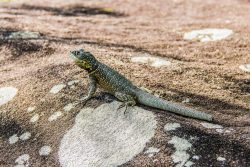 A researcher at the University of Guelph has discovered the gecko’s spinal cord tail houses a special cell type known as the radial glia. When the tail detaches, these cell types jump into action by making and proliferating different types of proteins in response to the injury. It is believed this discovery may have implications for spinal cord treatments in humans.
A researcher at the University of Guelph has discovered the gecko’s spinal cord tail houses a special cell type known as the radial glia. When the tail detaches, these cell types jump into action by making and proliferating different types of proteins in response to the injury. It is believed this discovery may have implications for spinal cord treatments in humans.
Many types of lizards are able to detach a portion of their tail in order to avoid predators. They can then regenerate a new one. Unlike mammals, lizard tails include a spinal cord. The researcher found the spinal cord of the tail contains a large number of proteins and stem cells which are known to support stem cell growth.
It has been known that the gecko’s spinal cord can regenerate. But it hasn’t been known until now which cells were playing a key role in this regeneration. People are extremely bad at dealing with injuries to the spinal cord. It is the hope that what has been learned from the geckos can coax human spinal cord injuries into repairing themselves.
Geckos can regrow a new tail within 30 days which is faster than any other lizard type. In the wild, they will detach their tail when a predator grabs them. The severed tail will continue to wiggle which distracts the predator long enough for the lizard to escape.
For the lab research, the researcher simulated this by pinching the gecko’s tail which caused it to drop. Once the tail has detached, the site of the tail loss will begin to repair itself. This will eventually lead to a new spinal cord and new tissue formation. For the study, the science professors investigated what would happen at the cellular level before and then after detachment.
The team discovered that the spinal cord of the gecko houses a special stem cell type and these stem cells are normally fairly quiet. However when the tail becomes detached, everything will change temporarily. The cells will begin making different proteins and will proliferate more in response to the tail injury.
Ultimately, a brand new spinal cord is made. Once the injury has healed and the spinal cord has been restored, the cells will return to a resting state.
People however, respond to spinal cord injuries by making scar tissue as opposed to new tissue. The scar tissue will seal the wound very quickly, however sealing the injury prevents any regeneration. This is a quick fix, however in the long term it is problematic.
This might be why humans have a limited ability to repair their spinal cord. Humans are missing the key types of cells required for regeneration.
The study is one of several parts of a series of investigations into the regenerative abilities of the central nervous system of geckos. The next part is to examine how the gecko makes new brain cells. Geckos can regenerate many tissue throughout the bodies which makes them ideal models for studying tissue
redevelopment and wound healing.
To view the original scientific study click below
Neural stem/progenitor cells are activated during tail regeneration in the leopard gecko





